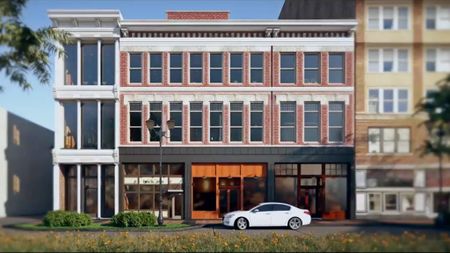Iron Age Project: Difference between revisions
No edit summary |
No edit summary |
||
| Line 1: | Line 1: | ||
[[File:Iron Age Project.jpg|right|thumb|450px|Rendering of the Iron Age Project]] | [[File:Iron Age Project.jpg|right|thumb|450px|Rendering of the Iron Age Project]] | ||
The '''Iron Age Project''' is a retail and office redevelopment of | The '''Iron Age Project''' is a 26,000 square-foot retail and office redevelopment of four adjoining buildings at 212-218 [[20th Street North]] in [[downtown Birmingham]]. | ||
[[Harsha Hatti]] purchased the [[218 20th Street North]] building in [[2003]] and renovated the ground floor for a restaurant tenant. [[Seafood D'Lite]] opened there in [[2008]], followed by [[Bistro 218]] in [[2012]]. | [[Harsha Hatti]] purchased the [[218 20th Street North]] building in [[2003]] and renovated the ground floor for a restaurant tenant. [[Seafood D'Lite]] opened there in [[2008]], followed by [[Bistro 218]] in [[2012]]. | ||
| Line 6: | Line 6: | ||
Hatti relocated his company, [[CoreLinQ Innovations]] to the upper floor of the [[214-216 20th Street North]] building in early [[2016]]. He later purchased the vacant [[Iron Age Building]] next door and moved ahead with a concept of a shared hub for healthcare technology startups. | Hatti relocated his company, [[CoreLinQ Innovations]] to the upper floor of the [[214-216 20th Street North]] building in early [[2016]]. He later purchased the vacant [[Iron Age Building]] next door and moved ahead with a concept of a shared hub for healthcare technology startups. | ||
Architect [[Randy Britton]] designed the renovations, and [[Robbie Dellinger]] was the general contractor. The completed | Architect [[Randy Britton]] designed the renovations, and [[Robbie Dellinger]] was the general contractor. Custom windows were constructed for the project by [[Jim Miller]]. | ||
The construction was financed by [[Southern States Bank]] with assistance from the [[Birmingham Department of Innovation and Economic Development]]. Hatti did not apply for Historic Tax Credits, citing an approach to preservation that conflicts with the tax requirements. The project was completed in late [[2019]]. | |||
==Tenants== | ==Tenants== | ||
| Line 25: | Line 27: | ||
* Poe, Kelly (January 20, 2017) "CoreLinQ HQ will anchor tech development on 20th Street." {{BN}} | * Poe, Kelly (January 20, 2017) "CoreLinQ HQ will anchor tech development on 20th Street." {{BN}} | ||
* Godwin, Brent (September 20, 2018) "Tech hub project on 20th Street eyes early 2019 completion." {{BBJ}} | * Godwin, Brent (September 20, 2018) "Tech hub project on 20th Street eyes early 2019 completion." {{BBJ}} | ||
* Van der Bijl, Hanno (October 16, 2019) "Several tenants coming to renovated Iron Age building on 20th Street." {{BBJ}} | |||
[[Category:Iron Age Project|*]] | [[Category:Iron Age Project|*]] | ||
[[Category:2019 buildings]] | [[Category:2019 buildings]] | ||
[[Category:Randy Britton buildings]] | [[Category:Randy Britton buildings]] | ||
Revision as of 17:00, 16 October 2019
The Iron Age Project is a 26,000 square-foot retail and office redevelopment of four adjoining buildings at 212-218 20th Street North in downtown Birmingham.
Harsha Hatti purchased the 218 20th Street North building in 2003 and renovated the ground floor for a restaurant tenant. Seafood D'Lite opened there in 2008, followed by Bistro 218 in 2012.
Hatti relocated his company, CoreLinQ Innovations to the upper floor of the 214-216 20th Street North building in early 2016. He later purchased the vacant Iron Age Building next door and moved ahead with a concept of a shared hub for healthcare technology startups.
Architect Randy Britton designed the renovations, and Robbie Dellinger was the general contractor. Custom windows were constructed for the project by Jim Miller.
The construction was financed by Southern States Bank with assistance from the Birmingham Department of Innovation and Economic Development. Hatti did not apply for Historic Tax Credits, citing an approach to preservation that conflicts with the tax requirements. The project was completed in late 2019.
Tenants
- Ground floor
- 212: Refined Bridal Boutique (2019-)
- 214: Brick & Tin (2010-)
- 216-218: Bistro Two Eighteen (2012-)
- Offices
- CORELinQ Innovations (2016-)
- GLOW (2019-)
- Sigao Studios (2019-)
- CODE-R Productions (2019-)
References
- Carlton, Bob (September 21, 2012) "Bistro 218 coming to restored downtown Birmingham site." The Birmingham News
- Godwin, Brent (October 28, 2015) "Tech startup to move local operations to downtown Birmingham." Birmingham Business Journal
- Godwin, Brent (September 8, 2016) "Company eyes creation of tech hot spot on 20th Street." Birmingham Business Journal
- Poe, Kelly (January 20, 2017) "CoreLinQ HQ will anchor tech development on 20th Street." The Birmingham News
- Godwin, Brent (September 20, 2018) "Tech hub project on 20th Street eyes early 2019 completion." Birmingham Business Journal
- Van der Bijl, Hanno (October 16, 2019) "Several tenants coming to renovated Iron Age building on 20th Street." Birmingham Business Journal
